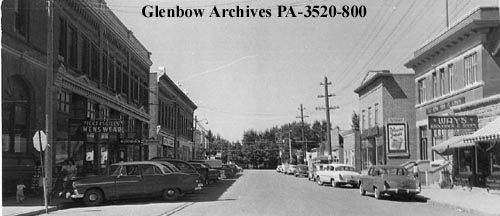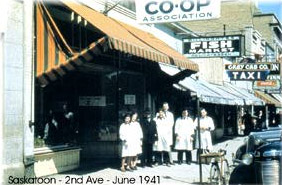High River, 1957
 Main street, High River, Alberta ca. 1957-1958. Glenbow Archives PA 3520-800
Main street, High River, Alberta ca. 1957-1958. Glenbow Archives PA 3520-800
A while ago I was writing something about when Starbucks started to appear in Canada in the late 1980s and how radical it was that their signs were flat to the wall. It seemed so sophisticated and European. We had always had projecting store signs like the signs shown in the past two days' posts, neon until the 1970s when they were gradually superseded by back-lit plastic, which I really hated, with a vengeance. Now hardly any signs project into this public realm, unless someone is being retro.
High River was and remains a very small town; its signs and awnings are modest – less money perhaps for commercial projection out into the street. Robson Street was and is in a city, more money, more people on the sidewalk. Pressure to redevelop and redevelop again means that Robson Street is a glassy glamorous canyon, while High River never experienced any pressure to redevelop itself, it just went out to the inevitable 1960s highway strip, thus little has changed from the view above.
What would that volume between building face and car grill, between cornice and pavement, be called? without using the word 'space'. And it divides into two parts, one the size of the building, the other the height of the ground floor.
There is a lot of clutter on these sidewalks of the 1950s; they are complex little environments. Here is a tiny photograph by Everett Baker, the photographer who travelled Saskatchewan with the wheat pool and then the Co-op, taking thousands of kodachrome slides. This picture is unfortunately tiny (the SHFS has a clamp on images), but could be a slice of either Vancouver's Robson Street or Hastings, or Broadway of the 1950s, or Oaxaca, or Elgin, Texas.
 Saskatoon, 2nd Avenue, 1941We have a call for articles on such things here. Some articles have already been proposed. Interestingly they are a lot about a rediscovery of small towns by urbanites leaving the metropoli with their iPads, iPhones and broadband needs. I suppose the question will be whether the small towns with their struggling main streets will change the incomers, slowing them down, or whether the urban emigrants will change the towns. The latter I think: one can get a latte everywhere now.
Saskatoon, 2nd Avenue, 1941We have a call for articles on such things here. Some articles have already been proposed. Interestingly they are a lot about a rediscovery of small towns by urbanites leaving the metropoli with their iPads, iPhones and broadband needs. I suppose the question will be whether the small towns with their struggling main streets will change the incomers, slowing them down, or whether the urban emigrants will change the towns. The latter I think: one can get a latte everywhere now.
